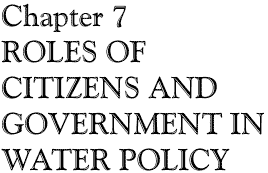
| ch. 7, pp. 102 - 103 |
Endangered Species Act The purpose of the Endangered Species Act (ESA), passed in 1973, is to conserve the nation’s biological heritage consisting of its animal and plant species. The law enlists all federal agencies and departments in an effort to conserve threatened and endangered species and to promote the purposes of the act. As stated in Section 7 of the act, all federal agencies are “to insure that actions authorized, funded, or carried out by them do not jeopardize the continued existence” of an endangered species or “result in the destruction or modification of habitat of such species.” Section 9 of the ESA includes prohibitions against “take” which is defined in the act as “harass, harm, pursue, hunt, shoot, wound, kill, trap, capture or collect or attempt to engage in any such conduct.” The ESA also charges the above agencies to identify and designate “critical habitat” for listed species, based upon the best scientific data available. This is to identify and protect habitat essential to the species’ survival and recovery. Critical habitat is the specific areas, within or outside the species’ geographical range at the time of listing, which contain essential physical or biological features for conserving the species and which may require special management or protection. When constructing the CAP canal in the Tucson area special precautions were taken to avoid harming various species. An important deer movement area between the Tucson Mountains and the Schuk Toak District of the Tohono O’odham Nation west of Tucson is crossed by the CAP canal. To minimize disruption to deer movement and other wildlife in this unique area and to preserve this corridor, the U.S. Bureau of Reclamation buried parts of the canal under six major washes and purchased 4.25 square miles of deer habitat. The corridor will be managed by Pima County as part of the Tucson Mountain Park system and will be protected from future development. This area also contains important habitat for the kit fox, the endangered Tumamoc globe-berry plant, and three potential endangered species: the desert tortoise, the Gila monster and the Thornber’s fishhook cactus. The corridor will protect about 27,000 Thornber’s fishhook cactus. Obviously any construction projects involving the movement and storage of water must proceed especially carefully to anticipate ESA concerns. Even now, with the CAP system essentially completed, the ESA continues to impact water resource planning. Along with water, the CAP brings fish and other aquatic species from the Colorado River. Some aggressive, non-native fish pose a potential threat to Arizona’s native fish species, all of which are listed as endangered or threatened. The concern is that during periods of high precipitation or snowmelt, when normally dry rivers are flowing, the CAP canal might provide a water link allowing non-native fish to reach the headwaters of streams, invading the habitat of native species. Eliminating such hazards can require building expensive fish barriers or other obstacles to non-native fish, resulting in water project delays and additional costs. The 19 largest municipal water providers within the Tucson area are listed in Figure 7-3. (See Appendix B for a list of all water providers in Pima County.) Tucson Water, the largest, serves about 80 percent of the total population. About 12 percent of the population is served by private domestic wells and a large number of very small companies. Different regulations regarding water rates apply to different types of water providers. Elected officials and the mandate of the electorate control municipal water companies. This can lead to disenfranchisement when the boundaries of the water company and the municipality are different. Also voters within the Tucson city limits who receive water from utilities such as Flowing Wells Irrigation District have the right to vote on Tucson Water issues. Both of these situations prevail in Tucson. Tucson Water’s service area extends far beyond city limits, and private water providers operate within city limits. Municipal water companies can approve increased rates, and they may float bond issues, spreading capital costs into future years. Private water companies and water cooperatives, on the other hand, are regulated by the ACC. Raising or restructuring rates requires ACC approval in a rate hearing. Private companies generally are not allowed to raise rates to recover future costs. For example, if ADWR requires conservation programs, the ACC may refuse a rate increase to cover the costs until after the money has been spent and the program proven to be effective. Similarly, a small water company cannot increase rates to build a new well or a treatment system. Instead, it must build the well or the treatment system, then recover the costs. Also ACC does not allow water companies to recover CAP holding costs. These are costs for CAP water rights not presently being used. As a result, private water companies and water cooperatives may find themselves in a regulatory bind. ACC’s goal is to keep rates low to benefit consumers; the ADWR goal is to conserve water within AMAs; and an ADEQ goal is to ensure safe drinking water quality. A private water company confronting these varied regulatory goals may have problems initiating conservation programs. Without the power to borrow money or float bonds, a small water company’s very survival may be threatened when major capital improvements are needed. The ACC does not regulate irrigation districts, regardless of whether they actually provide irrigation water (e.g., Flowing Wells) or water improvement districts (e.g., Metropolitan Domestic Water Improvement District). These districts are responsible solely to their boards and members. ADWR regulates all water providers regarding water supply (assured water supply and safe yield) and water use issues (conservation), with EPA and ADEQ regulating water quality issues.
|
